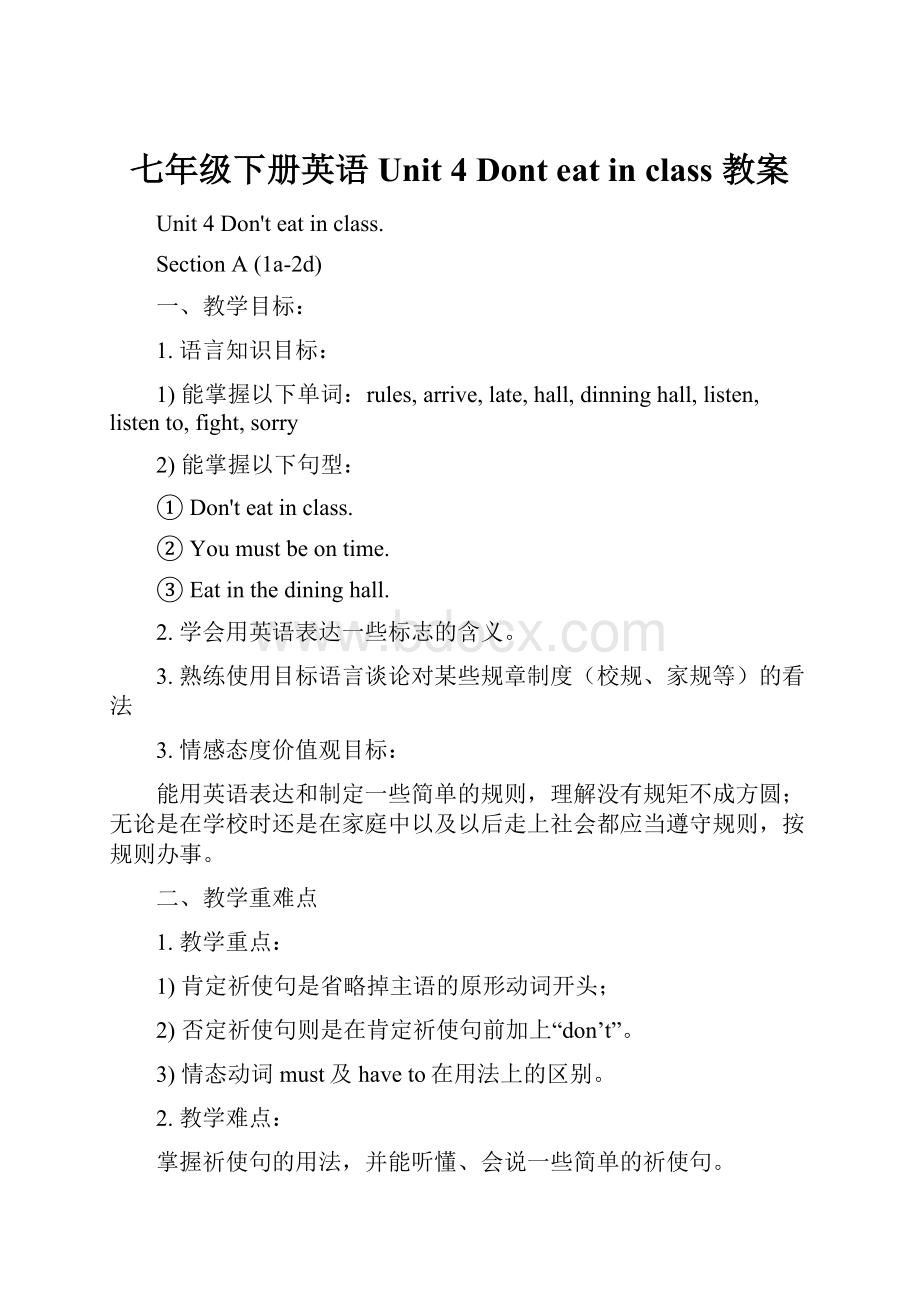七年级下册英语Unit 4Dont eat in class 教案.docx
《七年级下册英语Unit 4Dont eat in class 教案.docx》由会员分享,可在线阅读,更多相关《七年级下册英语Unit 4Dont eat in class 教案.docx(29页珍藏版)》请在冰豆网上搜索。

七年级下册英语Unit4Donteatinclass教案
Unit4Don'teatinclass.
SectionA(1a-2d)
一、教学目标:
1.语言知识目标:
1)能掌握以下单词:
rules,arrive,late,hall,dinninghall,listen,listento,fight,sorry
2)能掌握以下句型:
①Don'teatinclass.
②Youmustbeontime.
③Eatinthedininghall.
2.学会用英语表达一些标志的含义。
3.熟练使用目标语言谈论对某些规章制度(校规、家规等)的看法
3.情感态度价值观目标:
能用英语表达和制定一些简单的规则,理解没有规矩不成方圆;无论是在学校时还是在家庭中以及以后走上社会都应当遵守规则,按规则办事。
二、教学重难点
1.教学重点:
1)肯定祈使句是省略掉主语的原形动词开头;
2)否定祈使句则是在肯定祈使句前加上“don’t”。
3)情态动词must及haveto在用法上的区别。
2.教学难点:
掌握祈使句的用法,并能听懂、会说一些简单的祈使句。
三、教学过程
Ⅰ.Warming-upandrevision
教师进教室后,使用祈使句请学生们完成一系列动作:
Pleasestandup/sitdown.Closethedoor,please.Lookatmeandlistentome.
Don’topenyourbooks.Don’ttalk.Let’sbeginourclass.
学生听教师的指令完成各种动作,教师也可将指令写到黑板上,让学生从视觉上考察祈使句的特点。
Ⅱ.Presentation
教师出示书上1a的图片,向学生提问。
指着图上奔跑的男孩提问
T:
What’stheboydoing?
S:
He’srunning.
T:
Whereisherunning?
S:
He’srunninginthehallways.(板书,教读)
T:
Canyouruninthehallways?
S:
No,Ican’t.
T:
Sopleasedon’truninthehallways.(板书,教读)
(=Youcan’truninthehallways.)
学生跟读数遍,明白祈使句和“can”的表达含意。
T:
Whyisherunninginthehallways?
S:
He’slate.
T:
Oh,he’slateforclass.(板书,教读)
Youcan’tarrivelateforclass.(板书,教书)=Don’tarrivelateforclass.
…
Ⅲ.1a
T:
Now,Lookatthepictureonyourtextbook.Eachofthestudentsisbreakingoneoftheserules.
Pleasefinish1a.
学生看图,完成1a的内容,检查答案并大声朗读校规。
1.Don’tarrivelateforclass.Youmustbeontime.
2.Don’truninthehallways.
3.Don’teatintheclassroom.Youmusteatinthedininghall.
4.Don’tlistentomusicinclass.
5.Don’tfight.
Ⅳ.Listening
1.T:
Nowlet’slisten!
Whatrulesarethesestudentsbreaking?
Writethenumbersafternames?
2.学生们听录音,完成1b,选出四位学生都违反了哪条校规;听之前,学生要读会英文名。
Peter______Amy______Mike______
3.Checktheanswers:
4.Listenagainandcompletetheconversation.
Ms.Clark:
Hey,Peter.Youknowtherules.Don’t_________________.
Peter:
Sorry,Ms.Clark.
Mr.Smith:
Amy,don’t_______________________.
Amy:
Oh,sorry,Mr.Smith.
Mr.Smith:
Hey,Mike,don’t______________inclass.Mike!
Boy:
Hecan’thearyou,Mr.Smith.
Ⅴ.Pairwork
请两位学生朗读1c部分的句型;要求学生两人一组对话表演,SA扮演外校转来新生,SB告知本校校规。
(学生可经过讨论,多说出他们想到的校规,不必只限于书上;教师应给予帮助)
A:
Whataretherules?
B:
Well,wecan’tarrivelateforclass.Wemustbeontime.
…
Ⅵ.Listening
1.Workon2a:
First,let'sreadthesentencesin2atogether.
T:
Now,let'slistentotherecording.ChecktheactivitiesAlanandCindytalkabout.
Sslistentotherecordingandchecktheactivitiestheyhear.
1.___listentomusicintheclassroomorhallways
2.___listentomusicinmusicroom
3.___listentomusicoutside
4.___eatintheclassroom
5.___eatinthedinninghall
6.___eatoutside
7.___wearahat
8.___fight
PlaytherecordingagainfortheSstochecktheanswers.
2.Workon2b:
MakeSureSsknowwhattheyshoulddo.
Listentotherecordingagain.CanAlanandCindydotheseactivities?
Circlecanorcan'tabove.
1.___listentomusicintheclassroomorhallwayscancan’t
2.___listentomusicinmusicroomcancan’t
3.___listentomusicoutsidecancan’t
4.___eatintheclassroomcancan’t
5.___eatinthedinninghallcancan’t
6.___eatoutsidecancan’t
7.___wearahatcancan’t
8.___fightcancan’t
3.Checktheanswers:
Ⅶ.Pairwork
1.SupposeyouareAlanandyourpartnerisCindy.Talkabouttherulesin2a.
2.Letsomestudentscometothefrontandactouttheconversations.
Ⅷ.Reading
1.2dListenandanswerthequestions.
1)WhatareJohnandAlicetalkingabout?
2)HowmanyrulesdoesAlicemention?
2.Readtheconversationandanswerthequestions.
1)IsJohnnewatschool?
2)Aretheremanyrulesatschool?
3)Canhebringmusicplayerstoschool?
4)Dotheyhavetoalwaysweartheschooluniform?
3.Whatrulesdoestheschoolhave?
Dos
Weartheschooluniform
Bequietinthelibrary.
Don’ts
Don’tbelateforschool.
Don’tbringmusicplayerstoschool.
4.Role-playtheconversation.
IX.Languagepoints
1.Don’tarrivelateforclass.
arrivevi.到达=get(to)arrive后接表示地点的副词时,则不需要用介词。
e.g.Sheoftenarriveshomeat7:
30intheevening.
她经常晚上7:
30到家。
arrive要表示“到达某地”,后需加介词at(一般用于较小的地点)或in(一般用于较大的地点)。
e.g.They___________Beijingatsix他们六点钟到的北京。
Weusually__________thevillageinthemorning.
我们通常在早上到那个小村庄。
【链接】getto也可表示“到达某地”。
e.g.Iusually______________bybike.我通常骑自行车上学。
注意:
arrive和get后接here,there,home之类的副词时,不加介词。
e.g.Whendoyouusuallyarrive/gethome?
Iusuallyarrive/gethereatnoon.
根据句意选用get或 arrive填空,有的需要变换形式。
1.Wewill_______ Beijing thisafternoon.
2.David_____to London lastweek.
3.Yesterdaytheman__________attheairportontime.
4.We____________hereatfiveo’clockyesterday.
2.Don’t______________inclass.
2.Don’t______________inclass.
不能在教室里听音乐。
1)listenv.听;用来提醒某人注意,后面不跟事物。
e.g.听!
谁在教室里唱歌?
Listen!
Who’ssingingintheclassroom?
2)如果后面跟要听的事物,应跟介词to再跟事物。
e.g.__________ourteachercarefully.认真听老师讲。
hear listen
listen强调“听”的动作,是不及物动词,后面不能直接跟宾语,如果要表示“听……”时,常与介词to连用;hear强调“听”的结果,是及物动词。
e.g. Ican’thearyou.Pleasespeakloudly.
hearsb.+ do+ sth.表示“听见某人做了某事”,强调经常做或动作已经完成;
hearsb.doing+sth.表示“听见某人正在做某事”,强调动作正在进行。
e.g.我经常听到隔壁屋的女孩唱歌。
Ioftenhearthegirl_____inthenextroom.
我听到我妹妹这会在唱英语歌。
Ihearmysister_______anEnglishsongatthemoment.
请用hear或 listen的适当形式填空。
1. _______!
Whoaretalkingintheroom?
2.Weshould _________totheteachercarefully(认真地)inclass.
3.Lucy _______ himplayingtheguitarnow.
4.Ioften ________ MissWuspeakEnglish.
3.Don’tfight.
fight打架,争吵
1)作及物动词
e.g.Youcanfighthim,butcanyoubeathim?
你可以打他,但是你能打得过他吗?
2)作不及物动词
fightwith意为“和……打架/争辩”;
fightfor意为“为……打架/争辩”
e.g.他们为祖国而战。
They______________________.
杰克从不和他的弟弟打架。
Jacknever____________________.
3)作名词,意为“打架;争吵”;常用词组haveafight“打架;吵架”
e.g.Didyouhaveafightwithher?
你和她吵过架吗?
4.Andwealwayshavetoweartheschooluniform.
wearv.意为“穿、戴”,表示状态
e.g.MyauntwearsablueskirtandawhiteT-shirt.
我姑姑穿着蓝色的裙子,白色的T恤。
Doeshewearglasses?
他戴眼镜吗?
5.haveto与must
have to着重于客观的需要,含有“不得不”的客观强制性,有人称和数的变化,其后要跟动词原形。
must着重于主观上自己认为有义务、有必要,没有人称和数的变化,其后要跟动词原形。
e.g.She________cleantheroomeveryweek.她每周都得打扫房间。
I_________now.我现在必须走。
含有haveto的句子变一般疑问句或否定句时要借助助动词do/don’t或does/doesn’t;而含有must的句子变一般疑问句是直接将must提前至句首,变否定句是在must后加not。
如:
Hedoesn’thavetodoit.他不必做那件事。
Hemustn’tdoit.他不许做那件事。
Does he have to do it?
他不得不做那件事吗?
Musthedohishomework?
他必须做他的作业吗?
在否定句中,don’t/doesn’thave to表示“没有必要”,mustnot/mustn’t表示“不允许”。
如:
You don’t have to go there. 你不必去那儿。
Youmustnot/mustn’tgothere.你不许去那儿。
练一练:
用haveto,must填空。
1.It’scoldoutside.We______stayathome.
2.We____begoodwithourparents.
根据要求完成下列各题。
1.Hehastoweartheschooluniformatschool.(改为一般疑问句)
_____he________weartheschooluniformatschool?
2.Theyhavetodotoomuchhomeworkeveryday. (改为否定句)
They______________dotoomuchhomeworkeveryday.
3.Wemustfinishourworknow.(改为一般疑问句)
______we______ourworknow?
X.Exercises
1.不要在上课时听音乐。
2.我们必须准时。
3.我们能把音乐播放器带到学校里来吗?
4.在图书馆里我们必须保持安静。
5.不要在楼道里跑。
XI.Homework:
Writetherulesinyourschool.
提示:
1.上学不要迟到2.按时上课
3.穿校服4.不在教室里吃东西
5.不要在教室里戴帽子
6.在餐厅吃东西
SectionA(GrammarFocus-3c)
一、教学目标:
1.语言知识目标:
1)继续练习运用如何做自我介绍及问候他人。
学会从对话中获取对方的基本信息(询问他人姓名)。
能掌握以下句型:
①Don'teatinclass.
②Youmustbeontime.
③Eatinthedininghall.
2.情感态度价值观目标:
该部分继续学习使用目标语言谈论对某些规章制度(校规、家规等)的看法。
二、教学重难点
1.教学重点:
1)继续学习使用目标语言谈论对某些规章制度(校规、家规等)的看法
2)通过不同方式的练习方式来学会用英语表达一些标志的含义。
3)运用祈使句来表达一些规章和制度。
2.教学难点:
1)总结用祈使句、情态动词can、must及haveto来表达各种规章制度;
2)能用所学的知识来制定一些简单的规章制度。
三、教学过程
Ⅰ.Warming-upandrevision
1.GreettheSsasusual.
2.Checkthehomework.
Ⅱ.GrammarFocus.
1.学生阅读GrammarFocus中的句子,然后做填空练习。
①不要在楼道里跑。
_______________________
②不要打架。
____________________
③有什么规则?
___________________
④我们必须按时上课。
____________________
⑤我们可以在教室里吃东西吗?
____________________
⑥不能。
但我们可以在餐厅里吃东西。
___________________
⑦我们可以在教室里带帽子吗?
____________________
⑧他在学校里必须穿校服吗?
_________________________________
⑨是的,必须。
/不,不必。
_______________________________
⑩你们必须做什么?
_______________________________
⑪在图书馆里我们必须保持安静。
________________________________
2.Ssfinishoffthesentencesandchecktheanswersbythemselves.
3.GiveeightmoreminutesfortheSstorememberthesentences.
Ⅲ.Grammar
祈使句是表示请求、命令、建议等的句子。
句子中通常不出现主语,谓语动词一律用原形。
根据句子语气的强弱,句末用感叹号或句号。
一、祈使句的肯定式
1.以行为动词原形开头,简称Do型。
e.g.Comehere.到这儿来。
2.以动词be开头,简称Be型。
e.g.Bequiet,please.请安静。
3.以Let开头,简称Let型。
e.g.Let’sgo!
咱们走吧!
注意:
有时可在祈使句的句首或句尾加上please,使语气显得客气、有礼貌。
如果在句尾加please,应该用逗号与前句隔开。
e.g.Gothisway,please.请这边走。
二、祈使句的否定式
1.Do型和Be型的否定式是在句首加don’t。
e.g.Don’tsithere.不要坐在这儿。
Don’tbelate.别迟到。
2.以let开头的祈使句,其否定式有两种:
一种是直接在句首加don’t,另一种是“let+宾语+not+动词原形+(其他)”。
e.g.Don’tlethimgo.不要让他走。
Let’snotgothere.咱们别去那儿。
注意:
“No+名词/动词⁃ing形式”表示禁止或规劝,常用于公共场所。
e.g.Nophotos!
禁止拍照!
Nosmoking!
禁止吸烟!
将下列句子翻译成英语。
1.请看这幅图画。
2.不要在教室里跑。
3.让我们帮助他。
4.在图书馆保持安静。
5.上课不要迟到。
Ⅳ.Writing
1.Lookat3a.Doyouknowthemeaningofthesepictures?
Yeah,youseethemintheschoollibrary.Canyouwritetherulesfortheschoollibrary?
LibraryRules
Don’ttalk.
________________
________________
________________
2.Ssdiscussthepicturesandmakesomerules.
3.LetsomeSsreadtheirrulesaloud.
4.Checktheanswerswiththeclass.
(Don'tlistentomusicinthelibrary.Don'teatordrinkinthelibrary.Don'ttakephotosinthelibrary.)
Ⅴ.Practice
Workon3b:
1.T:
Usethewordstomakequestionsabouttherules.Thenwriteanswersaccordingtoyoursch